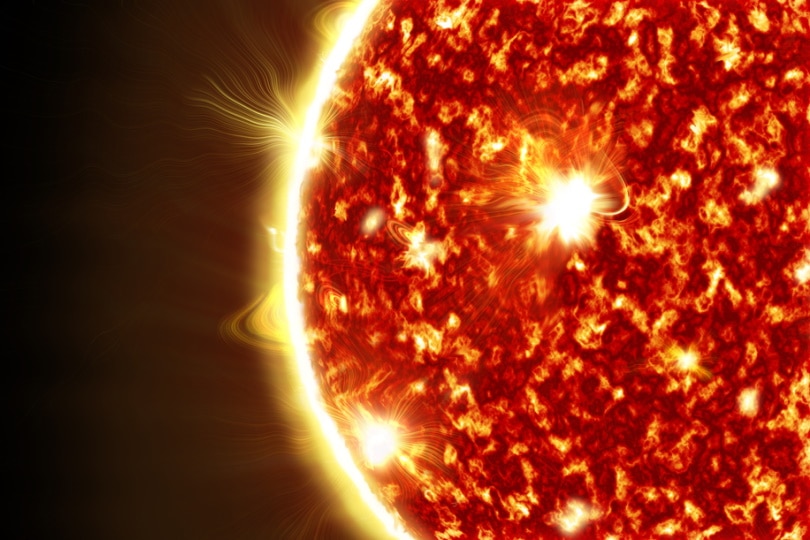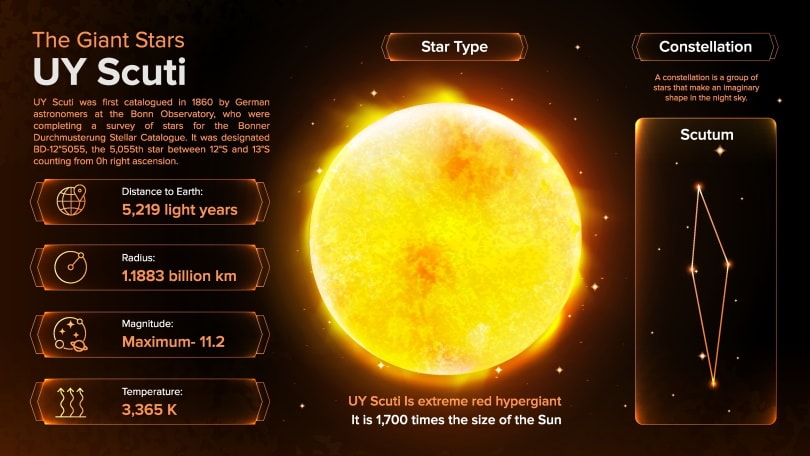What Is The Biggest Star Observed In The Universe?
Last Updated on

The Sun is indeed a massive gas ball. We know it can fit millions of planets and stars inside it, but it’s still not the biggest star observed in the universe. That is, until now. The reality is that it can be easily engulfed by many huge stars, especially UY Scuti.
The biggest star known in the universe is UY Scuti. It has a radius 1,700 times bigger than the Sun’s radius. This means it can carry around 5 billion Suns inside of it.
UY Scuti falls in the bright red supergiant stars group in the Scutum constellation. This massive star isn’t just about the size—there is so much more you must explore about UY Scuti. So, let’s do it in detail.

The History of UY Scuti
German astronomers working at the Bonn Observatory discovered UY Scuti in 1860. At that time, they named the star “BD 12 5055,” according to Astronomy Magazine. But unfortunately, it didn’t get documented immediately.
Later, in 2012, the latest technological equipment helped the star get documented. During the astronomers’ second observation, they found that UY Scuti became dimmer and brighter multiple times in 740 days. Thus, they classified it as a variable star.
Today, UY Scuti is the biggest star observed in the universe. It lies very close to the Milky Way’s center, approximately 9,500 light-years away from the Earth. More precisely, it is a hypergiant star in the constellation Scutum. In case you don’t know, the hypergiant stars are the largest, even bigger than giants and supergiants.
UY Scuti is one of the rarest stars that illuminates very brightly. Additionally, hypergiants lose a considerable amount of their mass via swift stellar winds.
The Size of UY Scuti

The Sun can be the closest star to the Earth, but UY Scuti currently tops the list of the biggest stars. It is because it has a mass 1 billion times more than the Sun.
It is a bright red supergiant with a radius 1,700 times greater than the Sun’s width. This equals 2.4 billion kilometers or 1.5 billion miles. However, this is just an average estimate with an error margin of ± 192 Sun’s radius. This means that UY Scuti can be as big as 1,900 or as little as 1,516 solar radii.
What Stars Are UY Scuti’s Strongest Contenders?
UY Scuti doesn’t have a definite radius, raising questions about whether it is the biggest or heaviest star in the universe. Multiple other stars can beat UY Scuti in radius and mass. If not yet, then indeed in the coming years.
Besides the star’s diffused surface, UY Scuti’s changing size also complicates determining the definite stellar radius. Thus, we have an upper and lower limit for its size, making up about 192 solar radii margin of error.
This size variation has made way for other stars to beat UY Scuti as the biggest star. According to an estimate, 30 stars are the strongest contenders in this race. So, what stars are contenders? Here are a few:
- RMC 136a1: Also known as R136a1, this star weighs about 300 times more than the Sun’s mass.
- WOH G64: At its discovery, WOH G64 had a radius of a whopping 3,000 times more than the Sun’s width. However, in 2009, the Astronomical Journal paper reported that the star’s size is around 1,500 solar radii. WOH G64 falls in the red hypergiant stars category, having a varying brightness like UY Scuti.
- Westerlund 1-26: NASA found that this star has a radius of more than 1,500 times the Sun’s width.
- NML Cygni: The strongest contender of UY Scuti is NML Cygni, measuring 1,640 times more than the Sun’s radius. These results were published in the Astronomy and Astrophysics Journal in 2012.
- KY Cygni: Like its sibling, KY Cygni is also looking forward to replacing UY Scuti as the biggest star in the universe. A 2020 paper published in the Astrophysics of Galaxies journal found that KY Cygni’s radius is close to 1,033 times more than the Sun’s width.
- VY Canis Majoris: As we discussed above, this star can be a promising contender to UY Scuti. In a 2012 study published in the Solar and Stellar Astrophysics Journal, VY Canis Majoris has a radius of 1,420 times more than the Sun’s width. Even after the new measurements, some astronomers still consider it the largest star.

Conclusion
UY Scuti is currently the biggest star known in the universe. It has a radius of 1,700 times more than the Sun’s radius. But many astronomers and astrophysicists are skeptical about UY Scuti being the biggest star.
Stars have a diffused surface instead of a solid, rigid one like planets. Thus, it’s almost impossible to determine their actual radius. All the stellar sizes that we have until now are all estimates based on the star’s photosphere.
It’s believed that VY Canis Majoris, KY Cygni, NML Cygni, or WOH G64 will soon beat UY Scuti.
Featured Image Credit: oneinchpunch, Shutterstock
About the Author Jeff Weishaupt
Jeff is a tech professional by day, writer, and amateur photographer by night. He's had the privilege of leading software teams for startups to the Fortune 100 over the past two decades. He currently works in the data privacy space. Jeff's amateur photography interests started in 2008 when he got his first DSLR camera, the Canon Rebel. Since then, he's taken tens of thousands of photos. His favorite handheld camera these days is his Google Pixel 6 XL. He loves taking photos of nature and his kids. In 2016, he bought his first drone, the Mavic Pro. Taking photos from the air is an amazing perspective, and he loves to take his drone while traveling.
Related Articles:
Binocular Magnification Chart: Numbers & Distances Compared
What Is the Best Binocular Magnification for Hunting? Optical Features Explained
When Were Binoculars Invented? History, Today & Future
Can You Use Binoculars to Look At Stars? How to Choose the Right Pair
How to Clean a Refractor Telescope: Step-by-Step Guide
How to Clean a Telescope Eyepiece: Step-by-Step Guide
How to Clean a Rifle Scope: 8 Expert Tips
Monocular vs Telescope: Differences Explained (With Pictures)
